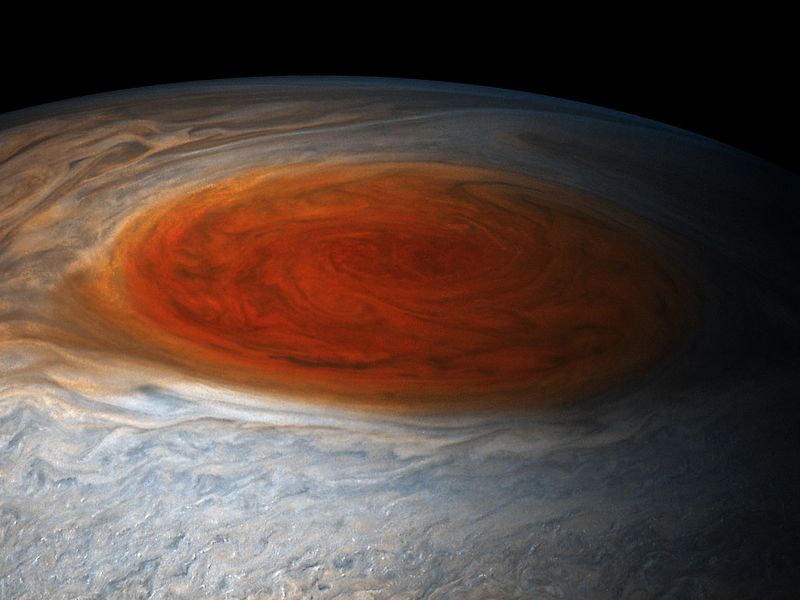
Researchers are beginning to unlock the secrets of the Great Red Spot on Jupiter – the biggest storm in the solar system.
Data collected during the mission reveals that the Great Red Spot is much deeper than previously believed with a depth 50 to 100 times deeper than Earth’s oceans.
“One of the most basic questions about Jupiter’s Great Red Spot is: how deep are the roots?” said Scott Bolton, Juno’s principal investigator, in a statement. “Juno data indicate that the solar system’s most famous storm is almost one-and-a-half Earths wide, and has roots that penetrate about 200 miles (300 kilometers) into the planet’s atmosphere.”
Before NASA released this animation and their latest findings, they initially only had still images.
“Now we have the best pictures ever of this iconic storm. It will take us some time to analyze all the data from not only JunoCam, but Juno’s eight science instruments, to shed some new light on the past, present and future of the Great Red Spot,” said Bolton.
As part of the project, citizen scientists took the raw images and processed them, offering an enhanced level of detail.
“I have been following the Juno mission since it launched,” said Jason Major, a JunoCam citizen scientist and a graphic designer from Warwick, Rhode Island, who created the image above. “It is always exciting to see these new raw images of Jupiter as they arrive. But it is even more thrilling to take the raw images and turn them into something that people can appreciate. That is what I live for.”
The raw images, as well as the citizen-scientist images, can be found at NASA’s Mission Juno site, and we’ll be sharing more images and information as we learn more.
Here’s some background on why this mission is such a big deal.
In case you haven’t noticed, there’s a storm on Jupiter that’s been raging for a really long time. We’re talking more than 150 years, and raging may not quite the right word for a weather phenomenon that screams to the tune of 400 mile-per-hour winds and covers an area bigger in diameter than our planet.
From back in the 1600s, when astronomers first ogled Jupiter — a perspective-shattering planet that’s 1,000 times the size of our own humble home base — its blazing birthmark has baffled mere humans.
While scientists don’t know whether our telescope-toting ancestors were eyeing the same storm — the gas giant is in a constant state of flux — they did eventually give that gargantuan crimson splotch a name: the Great Red Spot.
But soon, we might get a name that feels a little less “as-seen-through-a-telescope” and a little more detailed.
On July 10 at 10 p.m. EST, NASA’s Juno spacecraft will be closer to The Spot than any spacecraft has ever been before — a daunting 5,600 miles above Jupiter’s cloudy cusp.
The spacecraft, which has been tasked with the first in-depth exploration of Jupiter ever, just celebrated its first year in orbit last month. Today, it will literally stare down the a storm that spans some 10,000 miles.
Along the way, scientists are hoping to learn more about one of the solar system’s most enduring and iconic storms.
How we’ll learn Jupiter’s secrets
Juno is outfitted with equipment capable of capturing not only highly detailed images of the spot, but also measuring the storm’s most minute details.
“We don’t know what the Great Red Spot really looks like or even how it works,” Scott Bolton, Juno’s principal investigator from Southwest Research Institute, tells CBC News. “This is the largest storm in the solar system. This is it. This is the king. The king planet and the king storm.”
And the king, despite a flair for drama, may have a secret or two hidden behind the throne chair.
For one thing, scientists have long been baffled by the storm’s mercurial nature. Over the centuries, it has expanded and contracted in size, while its colors deepen and fade like a cosmic mood ring.
In fact, the Great Red Spot may not even be all that great any more, with scientists suggesting it has slimmed down from around 25,000 miles in the 1800s to its current span of 10,000.
NASA notes that the storm has never been so small, and may in fact, disappear completely over the next couple of decades.
Even more intriguing is the possibility of what we might eventually see in this settling storm.
Juno can even draw back the curtain of ever-swirling clouds and analyze the conditions in the atmosphere that make up the storm’s very foundation.
“It’s possible that the roots are quite deep,” Bolton tells Now Public Radio (NPR). “So we’ll be able to take a look at that and see what’s underneath the cloud tops.”
One by one, scientists expect to peel back the Great Red Spot’s secrets. But it won’t happen in just one fly-by. It takes the spacecraft roughly 53 days to orbit the gas giant — an uneven orbit that make take Juno dangerously closer to the surface on successive flybys.
But for each fly-by, Juno will focus its instruments on a different aspect of this many-layered storm system. But for the home audience, we can, at the very least, expect to gawk at images of the storm that we’ve never seen before.
“When you get really close, it’s really amazing,” Bolton tells CBC News. “It’s like a piece of art. We will see things that we’ve never seen before.”
Just don’t expect those planetary polaroids right away. It took Juno about five years to reach the distant gas giant, a journey spanning an astounding 1.74 billion miles. Data, travelling back and forth, will take a lot less time, somewhere around 88 minutes.
At some point, images will land here, where Earthlings can marvel and swoon at this perfect storm.













